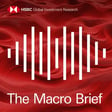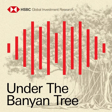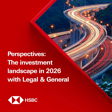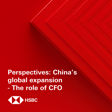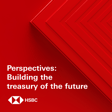Become a Creator today!Start creating today - Share your story with the world!
Start for free
00:00:00
00:00:01

The Macro Viewpoint - European economics, USD, PMI update
In this edition we assess the impact of the latest supply shock on Europe, consider what higher US interest rates mean for the dollar and find out what the latest PMI data are telling us about the global economy. Disclaimer: To stay connected and to access free to view reports and videos from HSBC Global Research click here.
Hosted on Acast. See acast.com/privacy for more information.
Transcript
Introduction to HSBC Global Viewpoint
00:00:00
Speaker
This is HSBC Global Viewpoint, your window into the thinking, trends and issues shaping global banking and markets.
00:00:09
Speaker
Join us as we hear from industry leaders and HSBC experts on the latest insights and opportunities for your business.
00:00:17
Speaker
Thank you for listening.
Weekly Review Overview: Mac Review Point
00:00:23
Speaker
You're listening to the HSBC Global Research Mac Review Point, our weekly review of the key reports from our economists and strategists across the globe.
00:00:33
Speaker
Coming up this week, we assess the impact of the latest supply shock on Europe.
00:00:39
Speaker
We consider whether higher US interest rates could lead to a weaker dollar.
00:00:43
Speaker
And we find out what the latest PMI data can tell us about the global economy.
00:00:49
Speaker
This podcast was recorded on Thursday, the 7th of April, 2022.
00:00:53
Speaker
Our full disclosures and disclaimers can be found in the link attached to this podcast.
00:01:00
Speaker
Hello, I'm Aline van Duyn.
00:01:02
Speaker
And I'm Piers Butler.
Europe's Economic Challenges
00:01:04
Speaker
We begin here in Europe, where the region's economies are battling a host of problems, from soaring energy prices and inflation to plummeting business expectations and consumer confidence.
00:01:16
Speaker
Simon Wells, Chief European Economist, and his team have just published our latest quarterly outlook.
00:01:21
Speaker
He joins me now.
00:01:23
Speaker
Simon, welcome to the podcast.
00:01:24
Speaker
Hi.
00:01:25
Speaker
So in essence, Simon, Europe is experiencing a huge supply shock.
00:01:29
Speaker
That's right.
00:01:29
Speaker
And let's not forget that this comes off the back of a previous supply shock in the form of Covid, which still hasn't fully worked its way through the economy.
00:01:39
Speaker
But what we have now is yet another sharp rise in energy prices, of course.
00:01:44
Speaker
There's also additional trade disruption and supply blockages, which had started to ease.
00:01:50
Speaker
But recent events obviously worsened that once again.
00:01:55
Speaker
But for Europe's economy, as a big net energy importer, it's obviously inflation, which is having the most acute effect here.
00:02:04
Speaker
So on our forecast, eurozone inflation remains above 7% through most of the year.
00:02:12
Speaker
UK inflation in April,
00:02:13
Speaker
could peak at 8.4% on our forecasts.
00:02:17
Speaker
And this, of course, entails a huge squeeze in real terms incomes for your average European household.
00:02:26
Speaker
So yes, a very big shock hitting Europe's economies.
Forecasting Europe's Slow Growth
00:02:30
Speaker
And how does that impact the outlook for growth in Europe?
00:02:34
Speaker
Well, as I say, the inflation squeezes real terms incomes because although wage growth might pick up a little bit for workers with strong bargaining power, it probably won't keep pace in aggregate.
00:02:47
Speaker
So we expect quite sizable falls in real terms household income this year.
00:02:52
Speaker
That should slow down growth alongside inflation.
00:02:56
Speaker
a greater uncertainty, and perhaps the impact of policy tightening as well.
00:03:01
Speaker
So all in all, we expect GDP to be a lot lower at the end of our forecast at the end of next year than we did three months ago.
00:03:10
Speaker
So we now forecast 2.6% growth for the eurozone this year, 1.8% growth for the eurozone next year.
00:03:19
Speaker
So what we're looking at relative to previous expectations is a very sharp slowdown
00:03:25
Speaker
But our central case is not for recession.
Potential Stagflation in Europe
00:03:28
Speaker
Fair enough.
00:03:28
Speaker
But the word on everyone's lips at the moment when they talk about economics is stagflation.
00:03:33
Speaker
What are the risks of that?
00:03:35
Speaker
Well, absolutely.
00:03:37
Speaker
In this report, we run through various scenarios, including a stagflationary scenario.
00:03:42
Speaker
And what we show is even if energy prices were to go back to their early March peaks and remain there, the additional inflation that would generate and the additional income squeeze would probably be enough to tip Europe into recession.
00:03:57
Speaker
On top of that, you potentially have rationing of energy, you have a bigger uncertainty effect.
00:04:02
Speaker
So the point is, it's very easy to generate stagflationary scenarios for the European economy.
00:04:08
Speaker
I quite agree.
00:04:09
Speaker
And it's not our central case because energy prices have moderated off their highs, but very easy to do.
00:04:15
Speaker
And I would also say our central case of 2.6% growth, a lot of that reflects the base effect from the sharp COVID recovery last year.
00:04:24
Speaker
You'd still get nearly 2% growth, even if there was no growth in any quarter of this year.
Balancing Inflation and Growth in Europe
00:04:30
Speaker
So what can policymakers do to avoid some of those risks, Simon?
00:04:34
Speaker
Well, that's the trillion euro question, isn't it?
00:04:38
Speaker
The central banks, of course, are caught between this very, very high level of inflation.
00:04:43
Speaker
But the knowledge that if they tighten too quickly or over tighten, they could intensify that income squeeze and be a trigger for potentially tipping the economy.
00:04:53
Speaker
into recession.
00:04:54
Speaker
Our central case is still that the central banks start raising rates through this year, but they will do so fairly cautiously, at least relative to the US Federal Reserve.
00:05:06
Speaker
For fiscal policy, that's the obvious tool to be used and indeed is being used to help households through this income squeeze.
00:05:13
Speaker
But even then, there are limits to what they can do.
00:05:16
Speaker
High debt burdens mean across Europe, governments are very sensitive now to rises in interest rates.
00:05:22
Speaker
And of course, borrowing costs are rising.
00:05:25
Speaker
So it's a tricky situation.
00:05:27
Speaker
Simon, thank you very much for joining us.
00:05:29
Speaker
Thank you, Pez.
Impact of US Interest Rates on the Dollar
00:05:33
Speaker
Let's get an update on the currency markets now with Paul Mackle, Global Head of FX Research.
00:05:39
Speaker
Paul, welcome to the podcast.
00:05:41
Speaker
Thank you very much.
00:05:42
Speaker
Paul, many now say that higher US interest rates should equal a weaker dollar.
00:05:47
Speaker
Do you agree?
00:05:48
Speaker
Well, the short answer is no, we haven't agreed with it for some time.
00:05:51
Speaker
I think many people were grabbing onto certain analogs and drawing comparisons to what would happen when the Fed lifted off in March this year.
00:06:01
Speaker
But we were pushing back against that view for a while, simply because there are periods in the past when the Fed started to raise interest rates, but the dollar actually stayed strong.
00:06:11
Speaker
We think very much that's the environment that we're in.
00:06:14
Speaker
There's been a lot of focus on interest rate curves and how certain segments have inversed recently.
00:06:20
Speaker
What do you think that means for the dollar?
00:06:23
Speaker
Well, again, I mean, we're encountering this thought process that this is something to worry about for the dollar from a cyclical perspective, but we don't agree with that.
00:06:31
Speaker
If you look back in time when the curve has been flattening, say something like twos, tens, or even inverted, actually the dollar was more likely to strengthen than weaken.
00:06:41
Speaker
You know, for us to get bearish on the dollar, we still come back to some of our key conditions.
00:06:47
Speaker
And that is we would need to see a much stronger reacceleration in global growth
00:06:51
Speaker
or perhaps a repricing lower of a Fed fund expectations or rate height expectations.
00:06:57
Speaker
But neither one of those two conditions are on the cards.
00:07:00
Speaker
So as I said, I think the dollar is going to stay stronger than probably people think.
Commodity Currencies: Strength and Risks
00:07:04
Speaker
And commodity currencies have been on a strong run recently.
00:07:08
Speaker
Do you see that continuing?
00:07:10
Speaker
We're probably more cautious now because they've had such a powerful run over the last few weeks.
00:07:15
Speaker
Now, commodity prices, as we know, have really lifted a lot of commodity currencies, whether in the developed markets like the Aussie dollar or some of the emerging market currencies like the Brazilian real.
00:07:25
Speaker
But I think we need to be a little bit careful because there's been such a potent amount of strength lately.
00:07:32
Speaker
And it doesn't fit with the backdrop for global growth that is clearly showing downside risks, at least over the next quarter or so.
00:07:39
Speaker
And normally that's happening.
00:07:40
Speaker
Those type of commodity currencies tend to underperform.
00:07:44
Speaker
We take a closer look at the outlook for the Australian dollar in the latest currency outlook.
00:07:49
Speaker
We've liked it for quite a long time, but now we're beginning to think it's looking overstretched.
00:07:55
Speaker
Paul, thanks very much.
00:07:56
Speaker
Thank you very much.
PMI Data Analysis
00:08:00
Speaker
We end this week with a look at the latest PMI data.
00:08:04
Speaker
James Pomeroy, global economist, has been assessing the numbers and what they can tell us about the state of the economy.
00:08:10
Speaker
He joins us now.
00:08:11
Speaker
So James, what are the latest headline data showing?
00:08:15
Speaker
So the global PMIs in March looked still relatively decent in terms of the growth outlook.
00:08:20
Speaker
Things clearly softened a little bit, a combination of
00:08:23
Speaker
higher prices, geopolitical tensions, of course, and higher numbers of COVID-19 cases in Asia, all weighing on the outlook.
00:08:32
Speaker
But the pace of growth is still relatively robust, all of that being considered based on those PMI figures.
00:08:39
Speaker
The really interesting part, though, is more on the pricing side, where we saw another pickup in input price components in both the manufacturing and the services side.
00:08:47
Speaker
And we're starting to see a resurgence in those output price indicators too, particularly
00:08:52
Speaker
on the services side of the economy.
00:08:55
Speaker
So it suggests that whilst activity may be slowing down a little bit, inflationary pressures continue to build.
00:09:01
Speaker
Are you seeing any differences between services and manufacturing?
China's COVID-19 Lockdowns and Economy
00:09:05
Speaker
So the manufacturing data almost universally softened just a little bit.
00:09:10
Speaker
Data still look pretty decent.
00:09:11
Speaker
There's still relatively robust demand for goods across the world.
00:09:15
Speaker
And those manufacturing numbers continue to reflect that.
00:09:17
Speaker
And those price increases are pretty evident in almost every single economy we get data for.
00:09:24
Speaker
The services side is a little bit more interesting.
00:09:27
Speaker
There's a little bit more divergence in the West, so in the US and in Western Europe.
00:09:32
Speaker
We've seen slightly better data actually in March, which would be a surprise given some of the cost of living squeezes and some of the uncertainty that's clearly increased in recent months.
00:09:43
Speaker
But most of this is because of the reopening of a lot of economies and the continued reopening of a lot of economies after restrictions came off at the beginning of the year.
00:09:52
Speaker
So there's still a little bit momentum.
00:09:54
Speaker
in the service sector in that part of the world.
00:09:56
Speaker
But we're seeing a very different story in China where things look a little bit softer.
00:10:01
Speaker
And let's look at China in more detail.
00:10:04
Speaker
COVID-19 cases have risen there, prompting further lockdown measures.
00:10:08
Speaker
What impact have these had?
00:10:10
Speaker
So the Chinese data have fallen off quite considerably in March, particularly in the service sector, where we saw the biggest drop in the PMI since the very beginning of 2020.
00:10:21
Speaker
So much, much weaker data on the service sector, manufacturing data a little weaker too.
00:10:26
Speaker
So clearly these restrictions that have come into place are having quite a big impact on the near term growth outlook, particularly affecting the service sector.
00:10:35
Speaker
as consumers either can't go out and spend or choosing to be much more cautious with their spending and that doesn't bode well for the near-term growth outlook.
Rising Input Costs and Inflation Concerns
00:10:44
Speaker
You mentioned some of these higher input cost indices.
00:10:47
Speaker
How worried should policymakers be?
00:10:49
Speaker
It's clearly a concern.
00:10:50
Speaker
A lot of these input costs are surging because of higher commodity prices but also higher wage costs, particularly in the service sector and policymakers across the world are already grappling
00:11:01
Speaker
We've got a whole range of different issues around inflation, high inflation, uncertain inflation.
00:11:06
Speaker
And these continued increases in these input costs are clearly going to add to that.
00:11:11
Speaker
For now, at least the spillover into output prices hasn't been quite as clear.
00:11:16
Speaker
But it's one of the big risks for inflation throughout 2022 is that businesses, given the relatively robust inflationary,
00:11:23
Speaker
demand outlook continue to pass more and more of these higher input costs on to consumers and therefore there is an upside risk to headline inflation rates from these very elevated input price and output price indices in the PMIs particularly in the service sector and where we're seeing costs rise very very quickly now.
00:11:43
Speaker
James thanks for the update.
00:11:45
Speaker
Thank you very much.
00:11:48
Speaker
So that's all from us today.
00:11:49
Speaker
Thank you to our guests, Simon Wells, Paul McEl, and James Pomeroy.
00:11:53
Speaker
Thanks very much for listening.
00:11:55
Speaker
We'll be back again next week.
00:12:03
Speaker
Thank you for listening today.
00:12:05
Speaker
This has been HSBC Global Viewpoint, Banking and Markets.
00:12:09
Speaker
For more information about anything you heard in this podcast or to learn about HSBC's global services and offerings, please visit gbm.hsbc.com.

